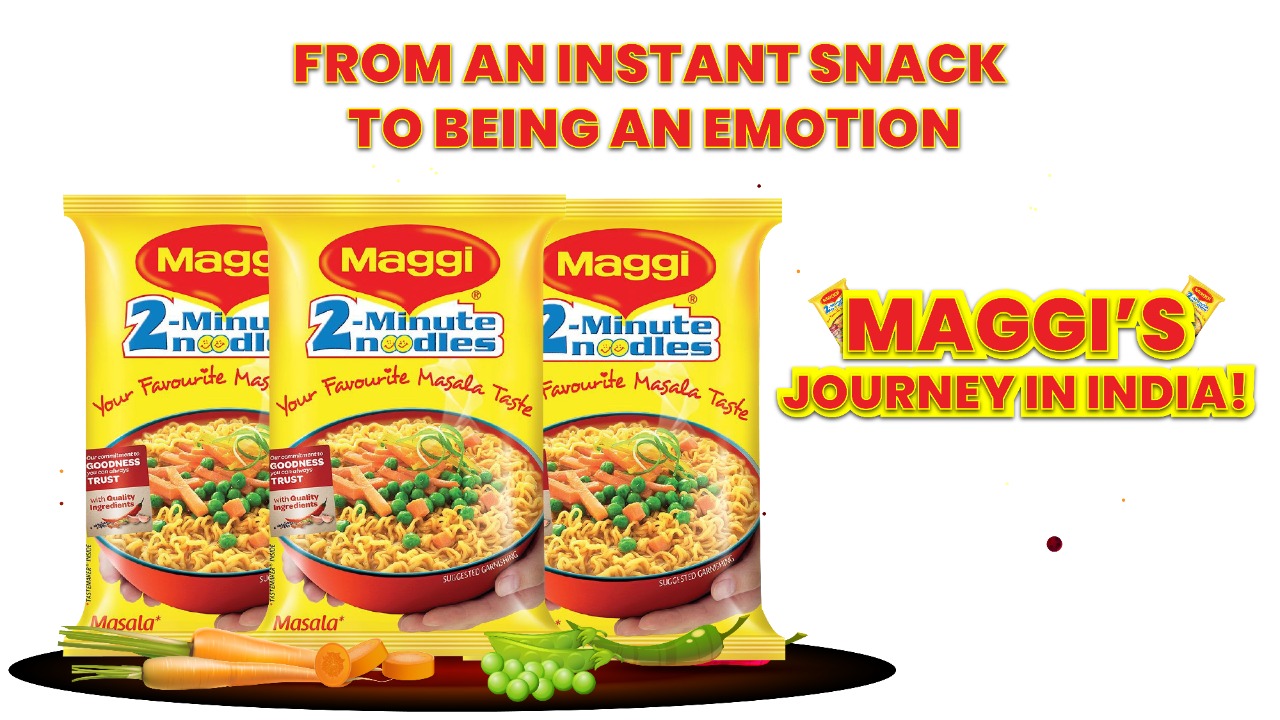As Indians, we have all grown up with a few things in common, one of them being the instant food that
can be cooked anywhere, anytime, and is loved by people from all the regions alike. That said, what is
the first thing that comes to your mind when you are famished and want something that can be cooked
in an instant?
Until the concept of instant food had grabbed the interest of Indians, food items that were served as
fast food included south Indian cuisines like Idli, Dosa, and Vada or Onion and potato fritters. But even
for these food items, a batter was required to be prepared and left overnight.
And then something that wasn’t expected to reach households so far and wide was launched in the
market. Maggi is not just food, rather an emotion that resonates with millions of people in the country.
Let’s take a look at how this instant snack made it to being soulful ever since it was introduced in the
Indian market.
Evolution of a brand
In the late 1800s, the Swiss government tasked a budding entrepreneur with a job to create a product
that would be quick to prepare yet nutritious and tasty, as more women were starting to move out of
their homes to work right after the industrial revolution phase in the country.
Thus, an ubiquitous brand was born which was beginning to receive love from every corner of the world.
Julius Maggi named the company Maggi, and countries like the United States and France began its
import in the early 1900s.
Beginning of a legacy in India
In 1947, when on one side the country united for its independence and new opportunities were starting
to open up for business, Nestle acquired Maggi and got the rights to introduce and market it in India.
While the product had been around for quite a while, it was only in the year 1983 when it started import
to India and rose to fame, and then on, there was no looking back.
Nestle’s Maggi noodles began its import in India during the World Cup when the Indian Cricket team
lifted the trophy and Maggi was promoted on all the channels- the black and white TV, the Radio, and
the print media. At a time when Indians were still getting used to chocolates being easily available and
affordable, Maggi had begun to show its magic and continued to become the choice of millions of
people. The idea and the product that was created in minutes were liked by everyone! But what worked
the best for Maggi and how it replaced the local recipes passed down from generations to make a
special place in the hearts of Indians is commendable.
Here’s the story of a few of the many campaigns that transformed Maggi into an emotion in India…
- Target Audience
At a time when the industrial revolution had left a positive impact on many other nations, India’s
industrial sector was in a poor state. It became imperative to emphasize on various industries resulting
in more women going to work. In an era, when women in India were expected to stay home, cook
meals, and take care of the kids, Maggi enabled them with a tool to satisfy the hunger pangs of their
children who refused to accept the cooking time.
It was during the late eighties when Maggi launched its Bas 2 minutes campaign targeting mothers and
kids, who were elated by the easy availability of an instant snack that was easy to make and equally
delicious at the same time. The urban hold for Maggi had gotten strong by receiving credit for sending a
liberating message to women.
2. Consumer Engagement
Within the first two decades of the formidable legacy it has established, Maggi was able to command
the quick noodles market it had created in the subcontinent. By the early 2000s, Maggi had found a
frantic, loyal consumer base in every corner of India within users of all kinds- hostelers, singles, couples,
families, travelers, soldiers, and whatnot, due to its easy availability and very little resources required for
cooking!
The year 2008- silver jubilee for Maggi’s launch in India, a time when digital transformation had a rising
curve, the brand seized the opportunity and launched the Me and meri Maggi campaign, inviting
consumers as users to send in their personal Maggi stories that would be portrayed in the TV ads to
follow. The response- more than 30,000 entries made it to their advertising agency.
3. Maggipreneurs
Maggi- Rs 10 per plate – How often do you come across such handwritten posters while traveling within
a city or anywhere in a semi-rural or rural area? With generations of Indians growing with it, Maggi was
successful in transcending all ages and economic divides. It spawned legions of Maggi entrepreneurs
who have been the hunger-backups for office-goers, college students, and travelers with nothing more
than a stove, a cheap utensil to cook in, and disposable cutlery at their command. Such is the effect of
this instant food, that these Maggipreneurs have used the same brand colors for their shop as Maggi’s
to grab their customers’ attention. After all, a lot goes over a hot, piping bowl of Maggi.
4. Expansion, taking the healthy route
Not long after the Meri Maggi campaign was successful, and Maggi continued to top the list of most
loved food of all times, did a wave strike questioning the unhealthy ingredients that go into the making
of the noodles. The Dal Atta Noodles from Maggi made of whole wheat and contained pulses was
positioned as a healthy snack. The Atta Noodles was then followed by other products over a span of five
years such as Maggi Oats noodles, Magic Cubes, and Masala-e-Magic for that perfect Indian meal.
5. Underrated crisis management
In 2015, Maggi became the centre of a massive food safety scandal wherein the FSSAI claimed that
Maggi tested positive for high lead content. A nationwide ban was later issued on all Maggi products.
Surprisingly, it took Nestle a long time to come up with a proper response to the accusation. Over
19,000 mentions since the controversy broke. And yet, the response was far from convincing. Not only
did Nestle deny the accusation, but also tried covering its back by accepting that the lead content and
other harmful substances in non-permissible limits are from the natural resources ingredients in the
noodles.
From replying late to trying to sweep it under the carpet, defending in the wrong way, and apologizing
when nothing worked- Nestle’s online reputation management saw it all and how!
In today’s fast-paced world, when conversations happen within seconds, it is important to keep your
customers engaged to maintain the brand impact and consumer loyalty. The fact that Maggi avoided all
interactions with its consumers on digital platforms for about two weeks after the findings, ended up
adding to the speculations.
In such a situation, their ORM and PR team could have taken an active approach and ensured a
corrective action to turn the upset customers on their side and eventually into brand loyalists! Such is
the importance of an experienced, knowledgeable, digital marketing and crisis management team.
Conclusion
Even since its launch in India, Maggi has consistently maintained a price that is affordable to everyone.
But here’s what worked for them.
- The “2-minute noodles” catchphrase that propelled an emotional relatability in Indians.
- Identification of target audience and consumer engagement.
What didn’t work: A below-average online reputation management and digital marketing plan, which
otherwise could have turned the situation in Maggi’s favour.



